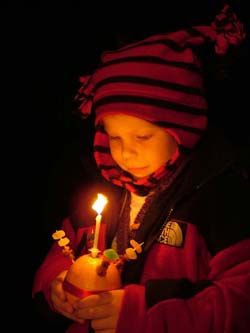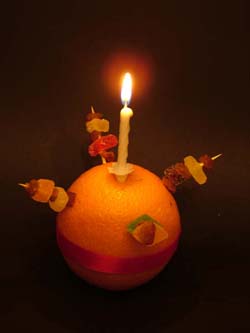Recalling the Meaning of Christmas: The Christingle Celebration
by Liz Hearn
 In 1749 in a church in Germany a Bishop started a Christmas
tradition that is loved by children and adults, and enjoyed in
Britain today and around the world. His name was Bishop John de
Watteville and he led worship among the Moravian Congregation in
Marienborn, Germany. He was the creator of the Christingle
service. Christingle means "Christ-Light."
In 1749 in a church in Germany a Bishop started a Christmas
tradition that is loved by children and adults, and enjoyed in
Britain today and around the world. His name was Bishop John de
Watteville and he led worship among the Moravian Congregation in
Marienborn, Germany. He was the creator of the Christingle
service. Christingle means "Christ-Light."
When the children are all charged up with energy about nativity
plays, gifts and shopping, Santa Claus and parties the
Christingle service is a nice way to remind them of the bigger
picture of who this new baby Jesus is and what he came to do. The
simple candle service that John de Watteville introduced showed
children then, as it does now, that through the gift of a lighted
candle we can remember that this baby Jesus brought light into
darkness and through the looped red ribbon that Jesus shed his
blood and died for our salvation. The Christingle has developed
over the last 250 years from a simple white candle to the
Christingle that is made today.
There is something special about an evening service for children.
The church is decorated for Christmas and the cold and dark in
the church makes the experience especially atmospheric. The
service is based around explaining the symbolism in the
Christingle and as each part in explained the Christingles are
assembled. When all is assembled the lights in the church are
dimmed and the candles lighted. Each child is given a Christingle
candle to take home with them. The candle light on the excited
children's faces is a beautiful sight. In John de Watteville's
day it is recorded that the children tried to keep their candles
alight the whole way home.
The use of the service was spread throughout the world by the
Moravian church and has been celebrated in many countries
including the USA. In 1968 the Christingle Service was brought to
the Anglican Church of England, its use promoted by The
Children's Society. This charity works in the UK with children at
risk of homelessness on the streets, disabled children, children
in trouble with the law, and young refugees. The Society
encourages churches and community groups to have a Christingle
service and the donated offering is often given to the Children's
Society to support their children's work throughout the year.
They also have a website where Christingle services that are
planned can be registered. If you are looking for a service near
you, this is one great way to find where and when they are
happening all over the United Kingdom. The service was created on
20th December 1749 and it is now often the service held the last
Sunday evening before Christmas or on Christmas Eve.
How to make a Christingle

- A sweet, juicy, shiny orange represents the goodness of
the earth that God created.
- Four sticks (cocktail sticks or tooth picks) are put into
four corners of the top side of the orange. These represent the
four seasons of the year.
- Onto each stick is threaded dried fruit like sultanas or
raisins. This represents all the goodness of the fruit of the
earth and the richness of animals and birds that God has provided
on his earth. Sometimes we use small jelly sweets or candy.
- A red ribbon wrapped around the orange and fixed in place
with a pin represents the blood of Jesus who died for the
salvation of the whole world. In the Moravian tradition today a
ribbon is looped around a candle at its base.
- The white candle is placed in the very top of the orange into
a pre-prepared hole. Sometimes some foil is used to help fix the
candle into position. This candle represents Jesus, the light of
the world, God's son. In the Moravian tradition it would be made
from beeswax and would also represent Christ's purity, as this
type of candle burns cleanly.
A modern British Christmas is secular in so many ways. Putting
the "Christ" back into Christmas is an important part of the
history of this festival period in England. Christianity might
not be your thing; however, everyone is welcome to witness and
take part in this traditional service.
Liz Hearn is a British freelance writer from the Wirral.
She writes children's articles and travel articles. Her articles
have been published in Transitions Abroad and
Highlights for Children. She lives overseas with her
husband and small daughter and currently lives in Beijing,
China.
Article and photos © 2005 Liz Hearn
|
